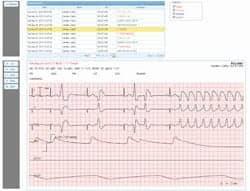With care increasingly delivered across many settings, health systems are reworking how technology is supported and secured.
By Shujah Dasgupta, vice president, medical technology, CitiusTech
Care delivery doesn’t look the way it used to. A decade ago, hospitals were the unquestioned center of the health universe. Today, recovery, monitoring, and even diagnosis spill out into long-term care centers, neighborhood clinics, and often, the patient’s own home.
That migration wasn’t just about convenience; it was necessity. Populations are aging faster than workforces can replenish, chronic disease has become the new epidemic, and health systems are under pressure to do more with less. Payers, in turn, have changed the rules of engagement. Value-based contracts now tie reimbursement to real outcomes.
To demonstrate those outcomes, providers need data that doesn’t stop at discharge. They need a live signal—like vital signs, medication adherence, and mobility metrics—that keeps flowing long after the hospital wristband comes off.
Site-neutral reimbursement models add another push. When regulators pay the same amount regardless of where care is delivered, hospitals must rethink what truly needs to stay within their four walls. Add to that new policies like the CONNECT for Health Act and the Health Tech Investment Act 2025, which expand telehealth and remote-monitoring coverage, and the direction of travel is clear: Connected care has moved from pilot to policy.
These frameworks make it easier for providers to bill for virtual visits and remote-monitoring time, incentivize technology investment across care settings, and accelerate US Food and Drug Administration (FDA) and Centers for Medicare and Medicaid Services pathways for digital-health and AI-enabled devices, turning connectivity from an operational choice into a reimbursement-driven necessity.
The Device as the New Care Interface
Connected care technologies transform isolated devices into integrated solutions across the care continuum. A glucose monitor, a patient monitor, or an infusion pump are no longer stand-alone instruments; they’re nodes in a living network that links the patient’s daily experience to the clinician’s line of sight. This shift can automate clinical workflows, provide data-driven insights for personalized medicine, and increase device utilization by care teams.
In acute care environments, this network is already visible. Closed-loop systems now integrate smart infusion pumps with patient monitors and anesthesia delivery systems to automate medication delivery in intensive care units. These ecosystems leverage clinical decision algorithms to adjust drug delivery based on real-time patient vitals—improving precision, reducing adverse events, and enhancing patient safety.
At the other end of the spectrum, home-based connected care is following a similar model. Closed-loop insulin-delivery systems link continuous glucose sensors with wearable insulin pumps via Bluetooth, adjusting basal rates every few minutes using predictive algorithms. These systems improve time-in-range outcomes and stream patient-generated data to cloud platforms, where clinicians can monitor progress remotely. The same digital spine, combining Software as a Medical Device (SaMD), mobile engagement apps, and cloud-based analytics, extends care from the hospital to the home, proving that connectivity is not just an enabler of access but a driver of safer, smarter care.
Devices are now expected to ensure not only precision but also context, security, and reliability. The FDA-cleared Apple Watch ECG and Fitbit’s heart-rate algorithms marked the first wave of this convergence. What once required hospital-grade equipment now sits on the wrist. Continuous glucose monitors, smart cardiac patches, and remote vital-sign trackers are managing chronic conditions, creating the Internet of Medical Things.
These connected endpoints are continuously exchanging data with clinical systems such as electronic health records and digital health platforms. The result is a shift from episodic to continuous care. Instead of snapshots, clinicians get a moving picture—a richer, contextual feed that allows them to intervene earlier and more precisely.
With that comes a new triangle of expectation. Patients want real-time education and feedback. Clinicians expect traceable accuracy and decision support. Regulators demand validation and auditability. To meet those expectations, device makers must design with clinical precision, transparent data lineage, and built-in governance.
Software as a Medical Instrument
Software has become an equal partner in this ecosystem. Algorithms that predict, diagnose, or guide treatment, collectively termed SaMD, now make up a growing share of FDA submissions every year. The old distinction between hardware and software has dissolved; what matters is whether the function influences a clinical decision.
Underneath it all lies a digital backbone that didn’t exist even five years ago:
- Cloud platforms that ingest and analyze signals from millions of endpoints, creating real-time visibility for clinicians, payers, and patients alike.
- Device connectivity and interoperability standards, such as HL7 FHIR, that make secure, API-driven data exchange a working reality rather than an aspiration.
- Artificial intelligence as the interpretive layer, turning raw sensor data into actionable insight—a patch detecting early cardiac stress, a glucose monitor adjusting insulin dosage on the fly.
- Augmented and virtual reality serve as an immersive visualization layer, transforming streams of sensor data into interactive 3D guidance to drive patient and provider engagement.
Modern home-based care leverages device connectivity, interoperability, cloud platforms, AI, and AR/VR to deliver advanced patient management outside hospitals. For example, heart failure patients use Bluetooth-enabled wearables that send real-time vitals to cloud platforms via HL7 FHIR integration, where AI predicts deteriorations and alerts clinicians for timely interventions through teleconsultation. Meanwhile, immersive VR rehabilitation programs combine wearable sensors and cloud analytics to personalize physical therapy at home, with AR overlays helping patients understand recovery progress while clinicians remotely customize therapy based on sensor data and AI-driven feedback. These ecosystems enhance clinical outcomes and patient engagement by uniting seamless device data flow, intelligent analytics, and immersive interfaces in distributed care models.
The result is a reshaping of the value chain itself. Device makers are becoming data stewards, responsible not only for how devices perform but also for how the information they generate is secured, shared, and interpreted. Cloud vendors are morphing into operational partners for health systems. And patients, equipped with connected sensors, are stepping into the role of active participants rather than passive recipients.
The Triple Challenge: Data, Trust, and Security
For all its promises, this transformation expands the surface area of responsibility. When a device becomes a node in a network rather than a product on a shelf, reliability extends far beyond hardware design. It includes data integrity, interoperability, and cybersecurity.
- Data and Interoperability: The growth of connected endpoints is outpacing many organizations’ ability to manage latency, cost, and data quality. Without standardization, data flows fragment between home, clinic, and cloud environments. Connectivity without interoperability quickly becomes chaos. HL7 FHIR has created a strong foundation, but successful implementation demands discipline—coordinated device design, system integration, workflow alignment, and governance.
- Security and Governance: A recent report found that 72% of US healthcare organizations have experienced cyberattacks that disrupted patient care. Each connected device represents both a data source and a potential vulnerability. As AI models evolve and software updates become continuous, risk profiles change daily. Security can’t be an afterthought. Principles such as zero-trust architecture—where no device or user is trusted by default—and secure-by-design engineering must be embedded from firmware to cloud.
- Trust and Reliability: Trust, once assumed within the hospital, must now be re-engineered across thousands of devices, vendors, and networks. A wearable at home must produce readings as dependable as a bedside monitor. Clinicians must trust the data. Payers must trust the outcomes. Patients must trust that their information remains private and meaningful.
What Healthcare Leaders Need to Prioritize
For manufacturers, payers, and health systems, the strategic question isn’t whether to join the connected-care movement but how to build it responsibly and at scale. Strategy must evolve from product thinking to system design. Four imperatives stand out:
- Design for continuity, not control. Devices should operate across settings without friction, carrying patient context seamlessly from home to clinic to hospital.
- Operationalize trust. Security, authentication, and continuous monitoring need to be engineered into every layer, not added after deployment.
- Invest in intelligence infrastructure. AI and analytics must sit at the core of architecture, transforming raw data into explainable, auditable insight. The ability to translate signals into clinical action will define competitiveness as much as accuracy or price.
- Mitigate risks. Strengthen cybersecurity and regulatory vigilance to safeguard connected ecosystems and maintain patient trust across every device interaction.
From Pilot to Platform
Connected care is quickly becoming the structural scaffolding of healthcare itself. As devices, data, and intelligence converge, the competitive frontier is shifting—from who builds the best device to who designs the most reliable system of care around it. Embracing connected care technologies is now a competitive necessity to deliver superior clinical outcomes, operational efficiency, and accelerated innovation while forging stronger partnerships with providers and payers.
Yet many medtech organizations remain stuck in pilot mode. Proof-of-concept programs deliver localized success but falter when asked to integrate into enterprise workflows. Moving from pilot to platform demands alignment across clinical, IT, and compliance functions—and a shared framework for data trust and accountability.
Those who succeed will treat connection as a core responsibility, not a technical feature. Their systems will be interoperable by default, secure by architecture, and transparent in how they use intelligence. When that happens, connected care won’t feel like a separate category at all. It will simply become healthcare as it was always meant to be: continuous, contextual, and connected.
ID 213874218 © Noipornpan | Dreamstime.com

About the Author: Shujah Dasgupta, vice president, medical technology at CitiusTech, is a health IT professional with over two decades of experience in designing and developing digital health solutions that address real-world clinical needs. He has spearheaded numerous strategic initiatives across the medical technology landscape, driving the development of next-generation healthcare products that blend clinical insight with innovation. His leadership and vision have shaped global healthcare standards, with contributions to organizations such as HL7, DICOM, and IHE.




